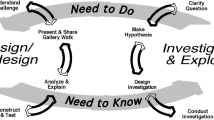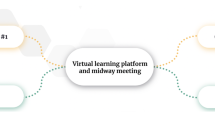Abstract
Supporting staff, as research and teaching assistants, in higher education carries significant pedagogical responsibility, especially in practice-based domains. In this respect, understanding the pedagogical roles of these participants of design studio courses is particularly critical. This study aims to investigate the research assistants’ pedagogical roles within design studio courses in Turkey through an exploratory sequential mixed method. Adopting a phenomenographic approach, the exploratory study, relying on semi-structured and in-depth interviews, was conducted with the voluntary participation of twenty-six research assistants from industrial design departments. Sequentially, a survey study was conducted to support the exploratory study. The findings show that there appear fifteen roles of research assistants, both pedagogical and non-pedagogical, active and passive teaching approaches, in-studio and out-of-studio contexts. The pedagogical roles were also discussed and mapped to compare with each other.

Similar content being viewed by others
Notes
The quotations were translated by the authors. Italics for emphasis.
References
Aguinis, H., & Solarino, A. M. (2019). Transparency and replicability in qualitative research: The case of interviews with elite informants. Strategic Management Journal, 40(8), 1291–1315. https://doi.org/10.1002/smj.3015
Attoe, W., & Mugerauer, R. (1991). Excellent studio teaching in architecture. Studies in Higher Education, 16(1), 41–50.
Aydın, İ., Erdemli Sildiroğlu, Ö., Güner Demir, T., & Toptaş, B. (2016). “Silence belongs to the young, speech belongs to the old”: The reason why research assistants remain silent. Journal of Education and Human Development, 5(4), 109–118. https://doi.org/10.15640/jehd.v5n4a11
Belluigi, D. Z. (2016). Constructions of roles in studio teaching and learning. The International Journal of Art & Design Education, 35(1), 21–35.
Bogdan, R. C., & Biklen, S. K. (2007). Qualitative research for education: An introduction to theory and methods (5th ed.). Pearson.
Bossu, C., Brown, N., & Warren, V. (2018). Professional and support staff in higher education: An introduction. Professional and Support Staff in Higher Education. Springer.
Botterill, M. (2018). Crossing boundaries: Projects, discourses, and visibility in the third space. Professional and Support Staff in Higher Education. Singapore: Springer.
Bowles, D., Radford, J., & Bakopoulou, I. (2017). Scaffolding as a key role for teaching assistants: Perceptions of their pedagogical strategies. British Journal of Educational Psychology, 88(3), 499–512. https://doi.org/10.1111/bjep.12197
Briggs, S. (2012). Changing roles and competencies of distance educators. Active Learning in Higher Education, 13(3), 256–268.
Britannica. (n.d.). Role. In Encyclopædia Britannica. Retrieved, February 6, 2021, from https://www.britannica.com/topic/discrimination-society
Buckley, J., Adams, L., Aribilola, I., Arshad, I., Azeem, M., Bracken, L., Breheny, C., Buckley, C., Chimello, I., Fagan, A., Fitzpatrick, D. P., Garza Herrera, D., Gomes, G. D., Grassick, S., Halligan, E., Hirway, A., Hyland, T., Imtiaz, M. B., Khan, M. B., … Zhang, L. (2021). An assessment of the transparency of contemporary technology education research employing interview-based methodologies. International Journal of Technology and Design Education. https://doi.org/10.1007/s10798-021-09695-1
Carril, P. C. M., Sanmamed, M. G., & Selles, N. H. (2013). Pedagogical roles and competencies of university teachers practicing in the e-learning environment. The International Review of Research in Open and Distance Learning, 14(3), 462–487. https://doi.org/10.19173/irrodl.v14i3.1477
Charmaz, K. (2014). Constructing grounded theory (2nd ed.). Sage.
Chikasanda, V. K. M., Otrel-Cass, K., Williams, J., & Jones, A. (2013). Enhancing teachers’ technological pedagogical knowledge and practices: A professional development model for technology teachers in Malawi. International Journal of Technology and Design Education, 23, 597–622. https://doi.org/10.1007/s10798-012-9206-8
Creswell, J. W., & Plano Clark, V. L. (2018). Designing and conducting mixed methods research (3rd ed.). Sage Publications.
Creswell, J. W., & Poth, C. N. (2018). Qualitative inquiry & research design: Choosing among five approaches (4th ed.). Sage.
Efilti, P., & Gelmez, K. (2021). Celebrating the variety, fighting the confusion: An integrative review of the design teacher’s pedagogical roles. Art, Design & Communication in Higher Education, 20(2), 243–287. https://doi.org/10.1386/adch_00041_1
Efilti, P., Gelmez, K., Tatlısu, E., Tüfek, T. E., & Yılmaz, O. (2022). Investigating the means utilized by the supporting staff in design studio courses: An interview study. In Research & Education in Design Conference (REDES) 2022 Conference, 19-20 May 2022. Lisbon, Portugal.
Flora, B. H. (2007). Graduate assistants: Students or staff, policy or practice? The current legal employment status of graduate assistants. Journal of Higher Education Policy and Management, 29(3), 315–322. https://doi.org/10.1080/13600800701460867
Gelmez, K., & Bağlı, H. (2018). Tracing design students’ affective journeys through reflective writing. International Journal of Technology and Design Education, 28(4), 1061–1081.
Gelmez, K., Efilti, P., Tatlısu, E., Tüfek, T., & Yılmaz, O. (2021). Framing research assistants’ pedagogical roles in design studio courses: Initial findings. In E. Bohemia, L.M. Nielsen, L. Pan, N.A.G.Z. Börekçi, Y. Zhang (Eds.), Learn X Design 2021: Engaging with challenges in design education, 24-26 September 2021, Shandong University of Art & Design, Jinan, China. https://doi.org/10.21606/drs_lxd2021.03.165
Goldschmidt, G., Hochman, H., & Dafni, I. (2010). The design studio ‘crit’: Teacher- student communication. Artificial Intelligence for Engineering Design, Analysis and Manufacturing, 24(3), 285.
Graham, C. (2012). Transforming spaces and identities: The contributions of professional staff to learning spaces in higher education. Journal of Higher Education Policy and Management, 34(4), 437–452. https://doi.org/10.1080/1360080X.2012.696326
Grasha, A. F. (1996). Teaching with style: A practical guide to enhancing learning by understanding teaching and learning styles. Alliance Publishers.
Gülmez, D., & Kozan, H. I. Ö. (2017). A study of research assistants’ perceptions about academic adviser and academic life through metaphors. Journal of Education and Practice, 8(7), 96–106.
Hobson, J., Jones, G., & Deane, E. (2005). The Research Assistant: Silenced partner in Australia's knowledge production? Journal of Higher Education Policy and Management, 27(3), 357–366. https://doi.org/10.1080/13600800500283890
Interpress. (2019). Retrieved from https://basin.yok.gov.tr/InternetHaberleriBelgeleri/İnternet%20Haber%20Belgeleri/2019/167_istatistikler_yayimlandi.pdf
Jones, A., & Moreland, J. (2004). Enhancing practicing primary school teachers’ pedagogical content knowledge in technology. International Journal of Technology and Design Education, 14, 121–140. https://doi.org/10.1023/B:ITDE.0000026513.48316.39
Kalaian, S. A. (2008). Frequency distribution. Encyclopedia of Survey Research Methods. Sage.
Kendall, D. K. & Schussler, E. E. (2012). Does instructor type matter? Undergraduate student perception of graduate teaching assistants and professors. CBE—Life Sciences Education, 11: 187–199.
Kisa, N. (2013). Metaphorical images of research assistants: Who are they? Who they should be? Mehmet Akif Ersoy University Journal of Education Faculty, 28, 47–66.
Larsson, J., & Holmström, I. (2007). Phenomenographic or phenomenological analysis: Does it matter? Examples from a study on anaesthesiologists’ work. International Journal of Qualitative Studies on Health and Well-Being, 2(1), 55–64. https://doi.org/10.1080/17482620601068105
Lavrakas, P. J. (2008). Relative frequency. Encyclopedia of Survey Research Methods. Sage.
Ledewitz, S. (1985). Models of design in studio teaching. Journal of Architectural Education, 38(2), 2.
Lueth, P. L. O. (2008). The architectural design studio as a learning environment: a qualitative exploration of architecture design student learning experiences in design studios from first- through fourth-year. Retrospective Theses and Dissertations, Iowa State University.
McGinn, M. K., Niemczyk, E. K., & Saudelli, M. G. (2013). Fulfilling an ethical obligation: An educative research assistantship. Alberta Journal of Educational Research, 59(1), 72–91.
McLain, M. (2021). Towards a signature pedagogy for design and technology education: A literature review. International Journal of Technology and Design Education. https://doi.org/10.1007/s10798-021-09667-5
Mishler, E. (1990). Validation in inquiry-guided research: The role of exemplars in narrative studies. Harvard Educational Review, 60(4), 415–442.
Mwasiaji, E., Mambo, S., Godfrey, S. M., & Okumu, J. (2021). Conceptualizing non-cognitive attributes, entrepreneurship training, pedagogical competencies and stem education outcome: An integrated model and research proposition. International Journal of Technology and Design Education. https://doi.org/10.1007/s10798-021-09671-9
Park, C. (2002). Neither fish nor fowl? The perceived benefits and problems of using graduate teaching assistants (GTAs) to teach undergraduate students. Higher Education Review, 35(1), 30–42.
Park, C. (2004). The graduate teaching assistant (GTA): Lessons from North American experience. Teaching in Higher Education, 9(3), 349–361. https://doi.org/10.1080/1356251042000216660
Radford, J., Bosanquet, P., Webster, R., & Blatchford, P. (2015). Scaffolding learning for independence: Clarifying teacher and TA roles for children with SEN. Learning and Instruction, 36, 1–10. https://doi.org/10.1016/j.learninstruc.2014.10.005
Richardson, J. T. E. (1999). The concepts and methods of phenomenographic research. Review of Educational Research, 69(1), 53–82.
Roberts, J. (2018). Future and changing roles of staff in distance education: A study to identify training and professional development needs. Distance Education, 39(1), 37–53. https://doi.org/10.1080/01587919.2017.1419818
Roberts, J., & Bezuidenhout, A. (2017). Technology, work roles and competencies of educators facilitating fully or partially via a distance. International Journal of Educational Sciences, 18(1–3), 110–121. https://doi.org/10.1080/09751122.2017.1305750
Rubie-Davies, C. M., Blatchford, P., Webster, R., Koutsoubou, M., & Bassett, P. (2010). Enhancing learning? A comparison of teacher and teaching assistant interactions with pupils. School Effectiveness and School Improvement, 21(4), 429–449. https://doi.org/10.1080/09243453.2010.512800
Ryttberg, M. (2020). Legitimacy dynamics of professional support staff at higher education institutions. Higher Education Policy. https://doi.org/10.1057/s41307-020-00206-w
Shapiro, J. K. (2008). Percentage frequency distribution. Encyclopedia of survey research methods. Sage.
Shreeve, A., & Batchelor, R. (2012). Designing relations in the studio: Ambiguity and uncertainty in one-to-one exchanges. Design and Technology Education: An International Journal, 3(17), 1.
Su, X., & Ding, B. (2022). A phenomenographic study of Chinese primary school students’ conceptions about technology. International Journal of Technology and Design Education. https://doi.org/10.1007/s10798-022-09742-5
Svensson, L. (1997). Theoretical foundations of phenomenography. Higher Education Research & Development, 16(2), 159–171. https://doi.org/10.1080/0729436970160204
Szekeres, J. (2011). Professional staff carve out a new space. Journal of Higher Education Policy and Management, 33(6), 679–691.
Şengül Avşar, A., & Barış Pekmezcioğlu, F. (2020). Araştırma görevliliğinde tek tip kadro türüne geçişte araştırma görevlilerinin görüşleri (Research assistants’ views on the transition to uniform staffing in research assistantship). Marmara Üniversitesi Atatürk Eğitim Fakültesi Eğitim Bilimleri Dergisi, 51, 50–71. https://doi.org/10.15285/maruaebd.655075
Thornberg, R., & Charmaz, K. (2014). Grounded theory and theoretical coding. In U. Flick (Ed.), The SAGE handbook of qualitative analysis (pp. 153–169). Sage.
Trigwell, K. (2000). A phenomenographic interview on phenomenography. In J. A. Bowden & E. Walsh (Eds.), Phenomenography (pp. 62–82). RMIT University Press.
Turkish Higher Education Law. (1981). Retrieved from https://www.mevzuat.gov.tr/MevzuatMetin/1.5.2547.pdf
Vaughn, W. (1998). Apprentice or employee? Graduate Students and Their Unions. Academe, 84(6), 43–49.
Verenikina, I. (2008). Scaffolding and learning: its role in nurturing new learners. In P. Kell, W. Vialle, D. Konza, G. Vogl (Eds.), Learning and the learner: exploring learning for new times, 161–180.
Webster, H. (2006). Power, freedom and resistance: Excavating the design jury. The International Journal of Art & Design Education, 25(3), 286–296. https://doi.org/10.1111/j.1476-8070,2006.00495.x
Webster, R., Blatchford, P., Bassett, P., Brown, P., Martin, C., & Russell, A. (2011). The wider pedagogical role of teaching assistants. School Leadership and Management, 31(1), 3–20. https://doi.org/10.1080/13632434.2010.540562
Whitchurch, C. (2008). Shifting identities and blurring boundaries: The emergence of third space professionals in UK higher education. Higher Education Quarterly, 62(4), 377–396.
Whitchurch, C. (2015). The rise of third space professionals: Paradoxes and dilemmas. In Forming, Recruiting and Managing the Academic Profession (pp. 79–99). New York: Springer.
Young, S. L., & Bippus, A. M. (2008). Assessment of Graduate Teaching Assistant (GTA) Training: A case study of a training program and its impact on GTAs. Communication Teacher, 22(4), 116–129. https://doi.org/10.1080/17404620802382680
Acknowledgements
This study (Project ID: MGA-2020-42555) was supported by Scientific Research Projects Department of Istanbul Technical University.We would like to thank the research assistants who participated in our study voluntarily. We would like to extend our gratitude to Tuğçe Ecem Tüfek Şerifoğlu, Enver Tatlısu and Onur Yılmaz for their valuable contributions.
Author information
Authors and Affiliations
Corresponding author
Additional information
Publisher's Note
Springer Nature remains neutral with regard to jurisdictional claims in published maps and institutional affiliations.
Rights and permissions
About this article
Cite this article
Efilti, P., Gelmez, K. A closer look into pedagogical roles of supporting staff in design studio courses: the case of research assistants in Turkey. Int J Technol Des Educ 33, 1143–1172 (2023). https://doi.org/10.1007/s10798-022-09760-3
Accepted:
Published:
Issue Date:
DOI: https://doi.org/10.1007/s10798-022-09760-3




